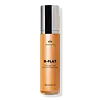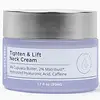What's inside
What's inside
 Key Ingredients
Key Ingredients

 Benefits
Benefits

 Concerns
Concerns

 Ingredients Side-by-side
Ingredients Side-by-side

Water
Skin ConditioningHydrogenated Polyisobutene
EmollientGlycerin
HumectantC12-15 Alkyl Benzoate
AntimicrobialStearyl Alcohol
EmollientCaprylic/Capric Triglyceride
MaskingAcrylates Copolymer
Cetyl Alcohol
EmollientDimethicone
EmollientSqualane
EmollientButyrospermum Parkii Butter
Skin ConditioningTheobroma Cacao Seed Butter
EmollientTocopheryl Acetate
AntioxidantSodium Hyaluronate
HumectantBentonite
AbsorbentPropylene Glycol
HumectantButylene Glycol
HumectantBisabolol
MaskingPaullinia Cupana Fruit Extract
Skin ConditioningSchinus Terebinthifolia Seed Extract
AstringentPersea Gratissima Fruit Extract
EmollientButyrospermum Parkii Butter Extract
Skin ConditioningTriticum Vulgare Germ Oil
EmollientEthylhexylglycerin
Skin ConditioningCeteareth-20
CleansingPhenoxyethanol
PreservativeVanillyl Butyl Ether
MaskingChlorphenesin
AntimicrobialSodium Hydroxide
BufferingSodium Carbonate
BufferingParfum
MaskingGeraniol
PerfumingHexyl Cinnamal
PerfumingLinalool
PerfumingCI 15985
Cosmetic ColorantCI 19140
Cosmetic ColorantCI 17200
Cosmetic ColorantWater, Hydrogenated Polyisobutene, Glycerin, C12-15 Alkyl Benzoate, Stearyl Alcohol, Caprylic/Capric Triglyceride, Acrylates Copolymer, Cetyl Alcohol, Dimethicone, Squalane, Butyrospermum Parkii Butter, Theobroma Cacao Seed Butter, Tocopheryl Acetate, Sodium Hyaluronate, Bentonite, Propylene Glycol, Butylene Glycol, Bisabolol, Paullinia Cupana Fruit Extract, Schinus Terebinthifolia Seed Extract, Persea Gratissima Fruit Extract, Butyrospermum Parkii Butter Extract, Triticum Vulgare Germ Oil, Ethylhexylglycerin, Ceteareth-20, Phenoxyethanol, Vanillyl Butyl Ether, Chlorphenesin, Sodium Hydroxide, Sodium Carbonate, Parfum, Geraniol, Hexyl Cinnamal, Linalool, CI 15985, CI 19140, CI 17200
Water
Skin ConditioningAloe Barbadensis Leaf Juice
Skin ConditioningDiisooctyl Succinate
EmollientTheobroma Grandiflorum Seed Butter
Skin ConditioningDiisopropyl Dimer Dilinoleate
EmollientPropanediol
SolventLimnanthes Alba Seed Oil
Skin ConditioningHydrogenated Ethylhexyl Olivate
EmollientHydrogenated Olive Oil Unsaponifiables
EmollientCaprylic/Capric Triglyceride
MaskingSimmondsia Chinensis Seed Oil
EmollientCetearyl Olivate
Sorbitan Olivate
EmulsifyingCetearyl Alcohol
EmollientCetyl Palmitate
EmollientSorbitan Palmitate
EmulsifyingSorbitan Oleate
EmulsifyingHydrolyzed Hyaluronic Acid
HumectantPiperonyl Glucoside
Skin ProtectingGlycerin
HumectantLecithin
EmollientCaffeine
Skin ConditioningPalmitoyl Carnitine
Skin ConditioningHydrolyzed Plukenetia Volubilis Seed Extract
Emulsion StabilisingGeranium Maculatum Extract
TonicEquisetum Arvense Extract
AstringentHamamelis Virginiana Bark/Leaf/Twig Extract
Skin ConditioningTaraxacum Officinale Extract
Skin ConditioningPropolis Extract
Skin ConditioningCamellia Sinensis Leaf Extract
AntimicrobialCentella Asiatica Extract
CleansingOryza Sativa Bran Extract
Skin ConditioningRosmarinus Officinalis Leaf Extract
AntimicrobialHelianthus Annuus Seed Extract
Skin ConditioningTocopherol
AntioxidantSimmondsia Chinensis Seed Extract
AbrasiveTamarindus Indica Seed Polysaccharide
Skin ConditioningLavandula Angustifolia Oil
MaskingCitric Acid
BufferingSclerotium Gum
Emulsion StabilisingPotassium Sorbate
PreservativeSodium Benzoate
Masking1,2-Hexanediol
Skin ConditioningCaprylyl Glycol
EmollientLonicera Caprifolium Flower Extract
PerfumingLonicera Japonica Flower Extract
Skin ConditioningWater, Aloe Barbadensis Leaf Juice, Diisooctyl Succinate, Theobroma Grandiflorum Seed Butter, Diisopropyl Dimer Dilinoleate, Propanediol, Limnanthes Alba Seed Oil, Hydrogenated Ethylhexyl Olivate, Hydrogenated Olive Oil Unsaponifiables, Caprylic/Capric Triglyceride, Simmondsia Chinensis Seed Oil, Cetearyl Olivate, Sorbitan Olivate, Cetearyl Alcohol, Cetyl Palmitate, Sorbitan Palmitate, Sorbitan Oleate, Hydrolyzed Hyaluronic Acid, Piperonyl Glucoside, Glycerin, Lecithin, Caffeine, Palmitoyl Carnitine, Hydrolyzed Plukenetia Volubilis Seed Extract, Geranium Maculatum Extract, Equisetum Arvense Extract, Hamamelis Virginiana Bark/Leaf/Twig Extract, Taraxacum Officinale Extract, Propolis Extract, Camellia Sinensis Leaf Extract, Centella Asiatica Extract, Oryza Sativa Bran Extract, Rosmarinus Officinalis Leaf Extract, Helianthus Annuus Seed Extract, Tocopherol, Simmondsia Chinensis Seed Extract, Tamarindus Indica Seed Polysaccharide, Lavandula Angustifolia Oil, Citric Acid, Sclerotium Gum, Potassium Sorbate, Sodium Benzoate, 1,2-Hexanediol, Caprylyl Glycol, Lonicera Caprifolium Flower Extract, Lonicera Japonica Flower Extract
Ingredients Explained
These ingredients are found in both products.
Ingredients higher up in an ingredient list are typically present in a larger amount.
This ingredient is an emollient, solvent, and texture enhancer. It is considered a skin-softener by helping the skin prevent moisture loss.
It helps thicken a product's formula and makes it easier to spread by dissolving clumping compounds.
Caprylic Triglyceride is made by combining glycerin with coconut oil, forming a clear liquid.
While there is an assumption Caprylic Triglyceride can clog pores due to it being derived from coconut oil, there is no research supporting this.
Learn more about Caprylic/Capric TriglycerideGlycerin is already naturally found in your skin. It helps moisturize and protect your skin.
A study from 2016 found glycerin to be more effective as a humectant than AHAs and hyaluronic acid.
As a humectant, it helps the skin stay hydrated by pulling moisture to your skin. The low molecular weight of glycerin allows it to pull moisture into the deeper layers of your skin.
Hydrated skin improves your skin barrier; Your skin barrier helps protect against irritants and bacteria.
Glycerin has also been found to have antimicrobial and antiviral properties. Due to these properties, glycerin is often used in wound and burn treatments.
In cosmetics, glycerin is usually derived from plants such as soybean or palm. However, it can also be sourced from animals, such as tallow or animal fat.
This ingredient is organic, colorless, odorless, and non-toxic.
Glycerin is the name for this ingredient in American English. British English uses Glycerol/Glycerine.
Learn more about GlycerinWater. It's the most common cosmetic ingredient of all. You'll usually see it at the top of ingredient lists, meaning that it makes up the largest part of the product.
So why is it so popular? Water most often acts as a solvent - this means that it helps dissolve other ingredients into the formulation.
You'll also recognize water as that liquid we all need to stay alive. If you see this, drink a glass of water. Stay hydrated!
Learn more about Water